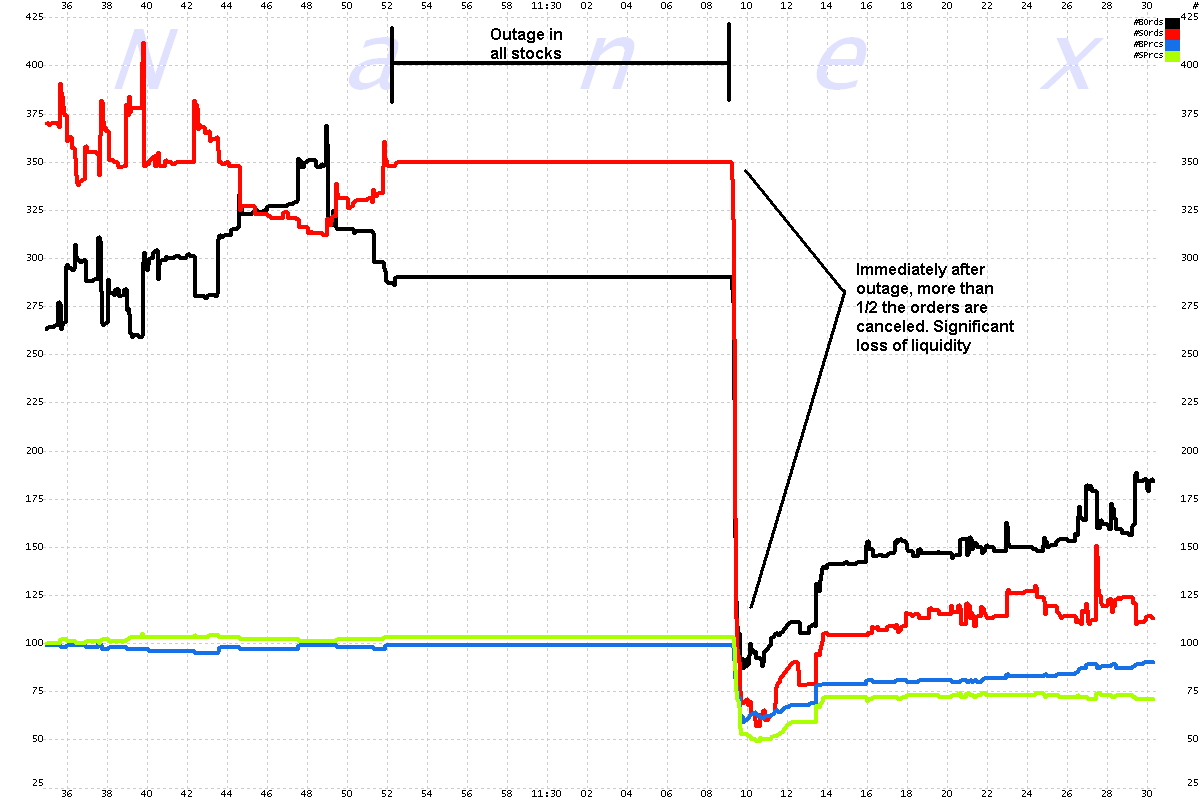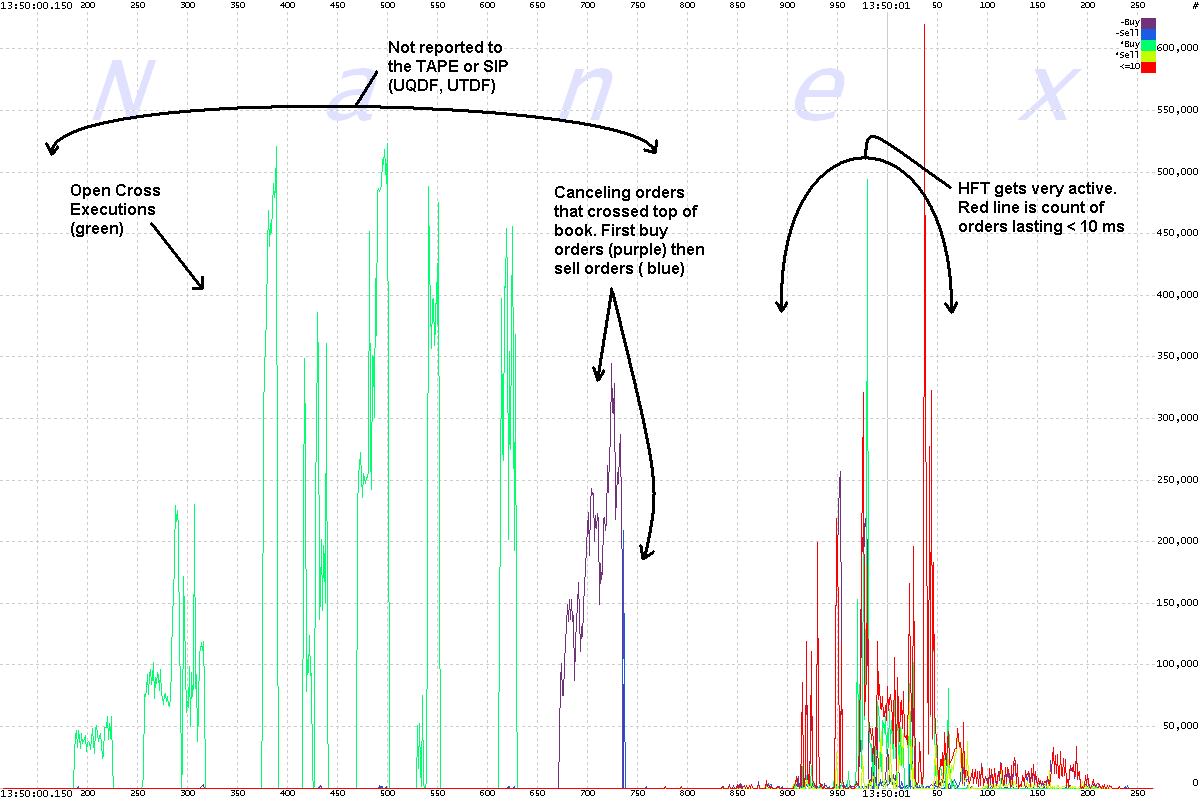Nanex Research

Nanex ~ 07-Jun-2012 ~ TotalView and the Facebook IPO
..and other random musings while looking at Nasdaq's order book (TotalView)
for FaceBook on May 18, 2012.
1. The Order Book was Crossed.
You read that right.
There were buy orders with prices higher than sell orders in the same order book. For
hours. The order book opened and remained crossed until 13:50, just like the top of book
quote sent to the SIP we reported
earlier. You had to purge all orders before 11:30:00 to have a correct
view of the order book (where the highest buy order price was less than the lowest sell order price). And not even Nasdaq could do this apparently, otherwise their quote to the SIP wouldn't
have been crossed. For hours.
Here's a handy tip for programmers new to writing exchange software:
if( buyOrder.price >= sellOrder.price )
executeTrade(buyOrder,sellOrder);
Funny thing, the crossed values sent to the SIP (bid $42.99, ask
$38.01) were different
than the crossed orders in the book (bid $4,200.00,
ask $25.00). Those crossed orders
were deleted from the book at 13:50,
so they were legitimate. The buy order for $4200 (seq#
104,047,820) isn't a typo, it was placed in the order book at 11:11:24.864
and canceled at 13:50:00.735.
That is several hours! Or in exchange marketing-speak, about 10 billion
microseconds. Yeah, we are rounding to the nearest billion.
Although we've written
this before, it's worth repeating:
We think it would be prudent for the SEC to clearly document how
an investor's order is routed through the system at each step in the process, in
detail, with particular attention paid to the step when the NBBO is taken into account.
Here's one question to ask: where did Nasdaq get the prices it was sending to the SIP
for its quote
(for example: bid 42.99 and ask 38.01)? And where is that process discussed
or allowed in Reg NMS?
2. There was 17 Seconds of Radio Silence in TotalView.
We previously reported
on the 17 seconds of silence from Nasdaq to level 1 feeds in all U.S. stocks between
11:29:52.506 and 11:30:09.206. It appears that this gap also occurred in the order book.We
spoke with several reporters about this gap and when they consulted with a "market pro",
the answer that came back was to the effect "there wasn't a problem with the book feeds,
it was only in the SIP", and at least one added "those nanex guys are amateurs".
CNBC - you got owned.
That's an inside joke (for now). But really, is there no one out there who uses TotalView
that didn't notice a 17,000,000 microsecond outage ? Really ?
The outage caused a sudden loss of liquidity in every stock we've looked at. The chart below shows one example, symbol SPY.
SPY: Chart of the number of buy (black) and sell (red) orders resting in the book, along with the number of different buy (blue) and sell (green) order prices.
Fewer orders mean less liquidity. The sudden disappearance of the feed resulted in an immediate, almost instantaneous evaporation in liquidity when it returned..

Zooming in shows the liquidity evaporation took less than 1/2 second.
Chart shows about 800 milliseconds.

Zooming out shows it lasted for the rest of the day!

3. The blast at 13:50 was not from the delayed opening trade reports.
Contrary to some reports, including
this recent interview by Maria Bartiromo (who did a superb
job, by the way), the enormous,
record setting blast of trades and quotes from the SIP (level
1 feed) in Facebook at 13:50
was mostly new orders and executions and only a tiny percentage was from
Nasdaq cleaning up its book. About 150 milliseconds after Nasdaq finished cleaning up it's book there was a sudden surge of new activity: rapid bursts of order adds/deletes which practically saturated TotalView and the SIP.
Timeline
- Open cross executions (green)..
- Buy orders that were placed before open and not executed are canceled (purple).
- Sell orders that were placed before open and not executed are canceled (blue).
This clears Nasdaq's crossed book, and also Nasdaq's quote on the SIP (UQDF).
- About 150ms later, a surge in a rapid cycle of adding and canceling of the same
order(s) (red).
1 millisecond interval chart showing buy and sell order deletes and executions,
plus orders
lasting less than 10 milliseconds. Chart shows about 1 second of time.
Scale values show implied per second rates: divide
by 1000 for actual counts.

4. Premarket Order Fills.
Here's how to tell when a buy order placed between 10:45 and 11:30 in the Nasdaq Order Book for the Facebook IPO
on May
18, 2012 was "executed" ('E' or 'F' message). This
would be the earliest possible time a customer would have received absolute confirmation
about that order.
There are 2 groups.
Group A: (156,219 trades) executed between 11:30:09.249 and 11:54:11.163
in order of descending price and ascending time. These are normal orders that were executed at
prevailing prices at other exchanges.
Buy order had limit price below $42
or
Buy order had limit price of $42.00 and was placed after 11:08:23.000
Group B: (40,417 trades) executed between13:50:00.187 and 13:50:00.629 (less
than 1/2 second).
And in the reverse order from Group A. That is, the first of these orders filled
had a price of $42 with the latest entry time. The $42 orders were
followed by the $42.01 price and so on, up to $77.
Buy order had limit price above $42
or
Buy order had limit price of $42.00 and was placed before 11:08:23.000
Since the number of trades involved in the late report is tiny (relatively speaking
compared to today's technology), and because all these trades were executed against
orders sitting in the book, we are flummoxed how it could take more than a few seconds
to notify everyone if they own the stock or not. Hours! ? Really?
5. There is no Sheriff in Town (SEC)
We don't think we'll ever get an answer to the most disturbing find
regarding the
Facebook IPO that we posed
on May 31, 2012
How can trading at Nasdaq not be affected, when our Regulation NMS requires
that orders must be routed to the exchange at the
National Best Bid or Offer (NBBO).
Nasdaq was not the NBBO for over 2 hours. How could a broker prove that a customer received
the best price when the only available (and official) audit trail (UQDF) doesn't include
Nasdaq
quotes for over 2 hours?
Reg NMS was hotly debated by many participants for well over a year.
Download the document and see how prescient some of the comments
from respected industry leaders were regarding how the system might be gamed, or issues
that may come up. Fast forward to today, where Reg NMS is
clearly not being followed. The Facebook IPO is a prime example
that's easy to see. The events that last way under a second are much more difficult.
And no one, it seems, other than a handful of people even understand the mechanics.
We are not suggesting new regulation or surveillance, or
transaction taxes. Nor are we suggesting that Reg NMS is flawless
or should be kept as is. We are simply stating that if you are going to have a law on the books, either enforce it, or rescind it. This whole business of wink wink nod nod is destroying the very fabric of our markets by letting unfairness creep in. And not in a way that we can measure until it's too late. Much like avoiding simple bridge maintenance such as painting it once a year. While that might save a little money and time, the
day will eventually come when you urgently need to drive a tank over that bridge, and that will be the day you discover just how cost effective your maintenance plan was.
6. So what is the point?
We'll end with a quote from us that appeared in a recent Securities Technology Monitor
article.
“Something needs to be done. If regulators shrug their shoulders and just move on from this, I’m done reporting problems having to do with the markets. It’s pointless then. Nobody is going to listen and nothing is going to happen from it.”
The events in Facebook are easy to unravel and present a textbook case of market dysfunction
on many levels. An example like this doesn't come along often. And if regulators can't
find answers to our questions above, they have no hope of finding answers to the many
and more difficult problems, some of which exist every minute of every trading day.
With no exaggeration, the Facebook event is 1000 times more transparent than the May 6,
2010
flash crash. And the next flash crash will have at least 10 times as much data.
This is likely to be our last post for some time.
We are taking a break. And waiting
to see what (if anything) the SEC has to say
on this matter. If they say nothing or if the end result is
the equivalent of a slap on the wrist, then it is more than likely that the SEC is owned.
Given that we have observed
hundreds of anomalies over the last year alone, with nary
a peep from the regulators, we think the
outlook is pretty bleak.
If you are concerned
about any of what we have written, we urge you to share that concern with your Congressman, or the President if he happens to be your golfing buddy. The message is simple: regulations are being ignored (even flaunted) and that is imposing a hidden tax on everyone.
Nanex Research




